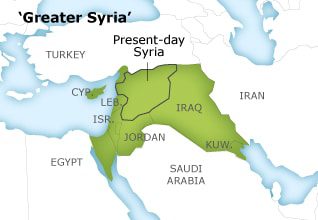
Introduction
The last decades of the 19th century saw the awakening of an Arab identity. Several factors contributed to this. The central power of the Ottoman Empire underwent notable modifications. The structures were modernized and, to an extent, democratized. At the same time, the Empire tightened its grip on unruly regions like Syria.
The modernization consisted of a series of reforms called Tanzimat, after the enthronement, in 1876, of a new Sultan in Istanbul, Abdülhamid II. The most essential reforms were the adoption of a constitution and the creation of a parliament, to which all the wilayat or vilayets in the Empire were supposed to send representatives.
Earlier, after the violence of 1860, Mount Lebanon had been cut off from the governorates – Damascus and Sidon – and transformed into an autonomous province. A newly created wilaya of Syria – uniting the former wilayat of Damascus and Sidon but not that of Aleppo – encompassed the central and southern part of present-day Syria, plus Palestine and present-day Jordan, and a large part of present-day Lebanon, excluding Mount Lebanon. The borders between the two newly created provinces were unclear, leading to frequent incidents.
Rise of Pan-Arabism
The feudal leaders of Mount Lebanon continued to exercise their influence under the new status. It was thus in their interest to uphold this new constitution, despite the economic problems it caused, as the province was now separated from the fertile Beqaa Valley and the prosperous coastal cities. In light thereof, the feudal leaders refused to send representatives to Istanbul, opposing the reforms promulgated by the grand vizier – reforms that were supposed to annul the special status of Mount Lebanon and to proclaim equal rights and duties for all the Sultan’s subjects. In reaction to all these changes imposed upon them, the Arab subjects of the Sultan began to stress their Arab identity, and like other nations within the Empire, started to consider their independence.
This sentiment increased as some Turkish governors milked the provinces they administrated and economic conditions became harsh. This pan-Arab movement, often referred to as al-Nahda (the Revival), spread quickly among the intellectual elite, in particular in effervescent Beirut. Christians – often educated either by French Jesuits or by English-speaking, protestant missionaries – played an important part in this Nahda movement, although it would later take on a religious dimension. Many newspapers were launched in the latter half of the 19th century – some of which still exist – and if the censorship in Beirut became too severe, writers and journalists took refuge in Cairo. These newspapers spread the idea of a Syrian identity as well as that of pan-Arabism.
Despite the feudal chiefs’ opposition to the reforms, elections did take place, in the Arab provinces as well as in the other regions of the Ottoman Empire. For the new representatives in the Turkish Parliament – and the Arab nationalists among them – this was a learning tool. The rise to power, in 1908, of the nationalist Young Turks, whose policy was to ‘Turkify’ and centralize the administration rather than to democratize it, put an end to the earlier reforms. This in turn strengthened the pan-Arab movement.
In 1913, an Arab Conference took place in Paris, despite attempts by the Young Turks to prevent it. The conference – 23 of the 25 participants were Muslim and Christian Syrians, the other two came from Iraq – called for reforms. The Turkish government’s reaction came a year later when World War I broke out and Turkey sided with Germany and Austria-Hungary against France, Britain, and Russia (until the Russian Revolution of 1917). Its support consisted mainly of sending troops to Lebanon.
Arab Revolt
The last years under Turkish rule were extremely harsh. There was famine, and dozens of popular leaders were executed by hanging, most of whom on 6 May 1916. A month later, the Sharif of the Holy Places Mecca and Medina, Husayn ibn Ali, symbolically ignited the Arab revolt that would eventually lead to the defeat of the Ottoman army, not just in the Arabian Peninsula and in Palestine, but in the whole of the Levant. To this end, Husayn’s sons Faysal and Abdullah joined forces with the British. In return, they were promised the Kingdom of Arabia. When, in 1917, the Russian Revolution put an end to Russia’s participation in the war, the Turks regained strength. Eventually, however, in the autumn of 1918, the Arab, British and French forces defeated the Turkish forces in the Levant. On 30 October 1918, the armistice was signed.

